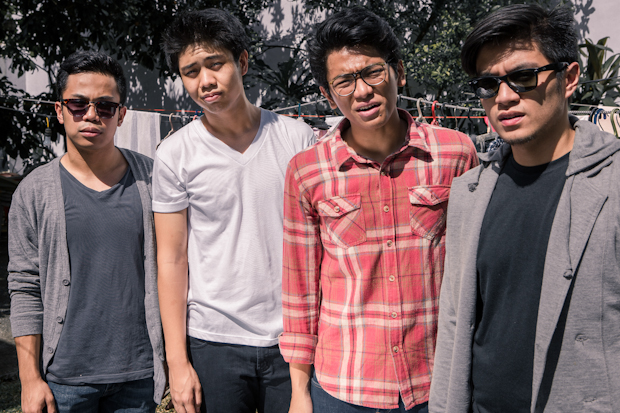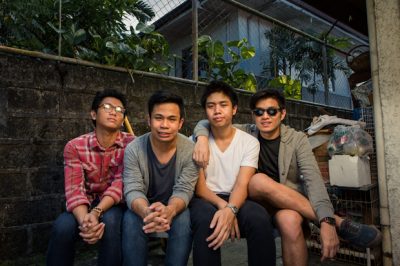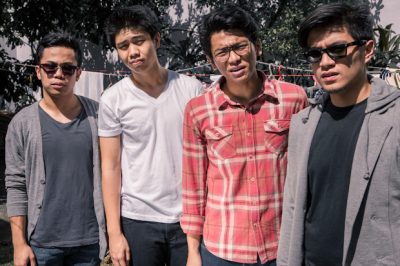
ROLLING THE DICE. The boys of She’s Only Sixteen are set on making it big in the local (and international) music scene. Photo at left shows Puentespina, Panopio, Seña and Silvoza (L-R). Photos by Ryan Y. Racca and Miguel R. Santiago
“Hopefully we get known as a band before ‘She’s Only Sixteen’ sounds creepy.”
This is the answer of guitarist Andrew Panopio, an information design sophomore, when asked what he and his bandmates hope to achieve. The boys of She’s Only Sixteen have been riding a growing wave of fame lately, and they intend to make it big. International kind of big.
Though a few Filipino artists have waded into the global music industry in the past, we’ve yet to see local talent secure lasting superstar status. But She’s Only Sixteen believes in their music far too much to be cowed, and they aren’t coy about it either: they dream of world tours, billboards, maybe even Grammy awards. With their eponymous debut EP freshly released, they’re out to prove that they’ve got more than just potential.
Staccato synthesis
Though they all hail from Ateneo High School, how Panopio, economics junior Anjo Silvoza, and De La Salle University students King Puentespina and Roberto Seña came to be She’s Only Sixteen isn’t a tidy story.
For starters, Silvoza is what Seña has dubbed an “incidental musician.” He attended his Ateneo Fresh Day, an event for Ateneo high school freshmen, to watch his friends perform, but two hours before their set, the bassist quit. “So my friends were like, ‘This is a bass guitar. Just press this a lot of times,’” Silvoza recalls.
By sophomore year, he was playing alongside Seña in a band called False Targets. When their vocalist left, Seña stepped up as frontman and the remaining members rebranded themselves as “She’s Only Sixteen,” inspired by the Red Hot Chili Peppers song “She’s Only 18.”
When the group went looking for a second guitarist, Panopio was shortlisted largely because of his taste in music. “Andrew and I were talking somewhere in Makati like, ‘Oh I like Arctic Monkeys, I like The Strokes,’” Seña says. “Then angels came over Andrew like, ‘This is the guy.’”
But not long after gaining a guitarist, they lost their drummer. With yet another hole in the line-up, they looked to other bands for sessionists. “I asked members of Imelda [a fellow Atenean-born band] if we could borrow [Puentespina] for a while,” says Seña. “Then eventually it wasn’t borrowing anymore.”
The band’s magnetic energy and charm are the products of what each of the boys bring to the table. Still, it’s no secret that, for many people, Seña is the main attraction. More than once, the crowd at their EP launch filled the air with spirited chants of “Seña hubad! Seña hubad!!
But Seña’s value goes far beyond the quintessential frontman appeal. “Seña writes the songs. As far as preproduction of a song goes, that’s pretty much it,” says Miguel Feria, Imelda’s guitarist. “But it’s also nice that the rest of the band is into the music he’s into. That way, they know more or less how Seña wants to execute the song as a band.”
The rest of them seem unfazed, if not amused, by the spotlight fans cast on Seña. But when it comes to the music, they agree ungrudgingly that losing him could very well mean the end of She’s Only Sixteen. “If ever things go downhill from Seña pursuing law and leaving the band, I’m okay with the band dissolving,” says Panopio.
Puentespina adds, “Quoting from High School Musical, ‘We’re all in this together.’”
Fine-tuning
Even with Seña around from the get-go, She’s Only Sixteen didn’t start off with the raw, up-tempo sound we know them for today. In the beginning, they were covering hip-hop songs.
“It was horrible,” says Silvoza. “It wasn’t something that you’d want to listen to on your iPod. It wasn’t talent. It was just copying.”
Thankfully, the band decided to trade in the Kanye renditions for a sound of their own. What exactly that sound is, however, the boys are reluctant to pinpoint.
For now, it draws from The Strokes, the Arctic Monkeys, Phoenix and a bit of Vampire Weekend, but they avoid boxing it into a genre. “We want to give ourselves room to grow as a band,” explains Puentespina.
But in a previous interview with The GUIDON, Seña labeled their music as “indie/post-punk.” When this is pointed out to the rest, there’s instant uproar. “Ha? Sinabi mo yun? (What? You said that?)” demands Panopio.
Quick to defend himself, Seña says their sound is guided by the music that appeals to them. “Right now, that’s indie/post-punk. As what they listen to changes, what they play will change as well.
“You know how when you listen to a band, the first album will sound a lot different from the sixth album?” says Seña. “Like, what the fuck happened? I want it like that.”
Understandable, but also potentially problematic. When musicians become famous, their audiences come to expect that they’ll sound a certain way. By altering that sound, they run the risk of losing the crowd that first gifted them with fame. Even with dreams as big as theirs, though, the boys agree that they’d take their chances.
“I’d rather be happy with what I’m doing than playing ‘Dying to Meet You’ for the next 20 years. I’m already sick of the song now,” says Seña, referring to the single that jumpstarted their popularity. Catchy and pulsating with relationship distress, it’s an easy crowd favorite.
In fact, someone later suggests scrapping it from the EP launch set list. But Panopio, with a touch of indignation, reminds them that “it’s the best song they think we have.” It stays put.
True enough, they played only the first few chords at the EP launch before the crowd erupted in cheers.
Perfect pitch
College groups releasing EPs aren’t unheard of, but staying together post-graduation is less common. That doesn’t trouble this band, though, as they were signed by Orion Entertainment/Universal Studios in July of this year. With a record deal intact, they’re open to breaking into the mainstream. Already, their music video for “Dying to Meet You” is being aired on local television.
Now, this isn’t the go signal for fans to mourn the band’s death-by-mainstream. Contrary to hipster mentality, the boys insist they can secure a spot in the limelight without caving into to the formula of sellout artists.
“Orion gives us money to record but we asked if it’s okay that we don’t let them change the sound,” says Panopio. “It’s only selling out if you’re playing something you don’t like.”
The future looks bright for them in the local music scene, but global fame could be a long way coming. Miles Malferrari, an interdisciplinary studies junior and member of the Ateneo Musicians’ Pool (of which She’s Only Sixteen is also part) pins this on “people who think that they’re just copying other bands.”
As a matter of fact, the band may have abandoned its covers, but the boys still hear it said that they bear a striking resemblance to their musical influences—particularly to those mentioned above.
Like many artists groping for a foothold in the industry, they don’t enjoy the comparison. “It was flattering at first, but now I don’t like hearing it as much,” says Seña. “I want to sound like She s Only Sixteen, [not] like the Arctic Monkeys.”
But they come off somewhat fickle on this one; ironically, they too confess to the similarity. “We do sound like The Strokes, I will admit that,” says Panopio.
“That’s what we listen to. It pretty much translates naman [to] how you write a song… So yeah, we do sound like The Strokes for now,” says Seña. They can justify the likeness, but looking to be known for a sound that’s She’s Only Sixteen’s may be a lot to ask when they themselves are still calling it something else.
Striking a chord
But having their originality called into question hasn’t made even a dent in the escalation of their popularity. Their launch filled Route 196 to near bursting, and their fan base is only continuing to swell. This is partly because the boys take a shamelessly active role in their own promotion.
It began with the release of “Dying to Meet You,” their first single. “We tried to promote it in every place possible. We’d announce it during gigs, we’d post it on random [Facebook] walls,” says Silvoza.
Today, Seña says, “When you search ‘She’s Only Sixteen’ on Twitter—I do that, like, daily—and then they’ll be like, ‘Oh, I found this band and they’re really cool,’ I retweet that.”
They may be pushing to actualize their dreams of global renown, but it’s with no resentment toward the local industry.
“I want to start here first,” says Silvoza. “All the other [local] bands, I want them to think that they can make it din.”
“I feel bad when people say, ‘You guys sound so foreign,’” says Panopio. They have this stigma that Filipino music isn’t supposed to sound that good.”
Some think they teeter on the edge of self-importance, and their surefootedness makes it easy to forget that their careers have just begun. But the band’s ambition is refreshing.
OPM has been rumored dead, as has popular music dictated by artists instead of producers. Perhaps She’s Only Sixteen is our shot at their revival.
- ROLLING THE DICE. The boys of She’s Only Sixteen are set on making it big in the local (and international) music scene. Photo at left shows Puentespina, Panopio, Seña and Silvoza (L-R). Photos by Ryan Y. Racca and Miguel R. Santiago














